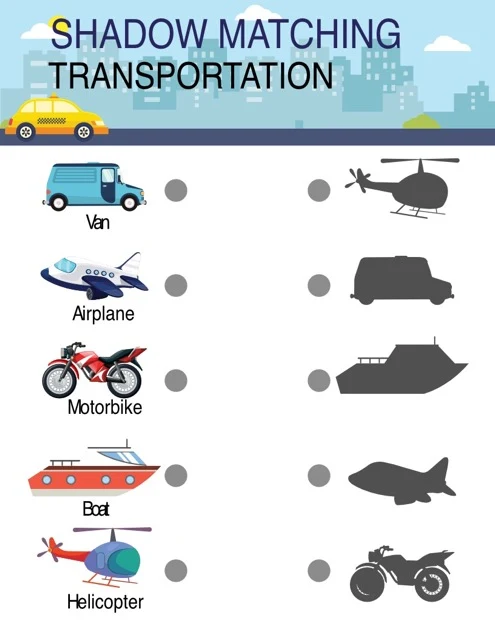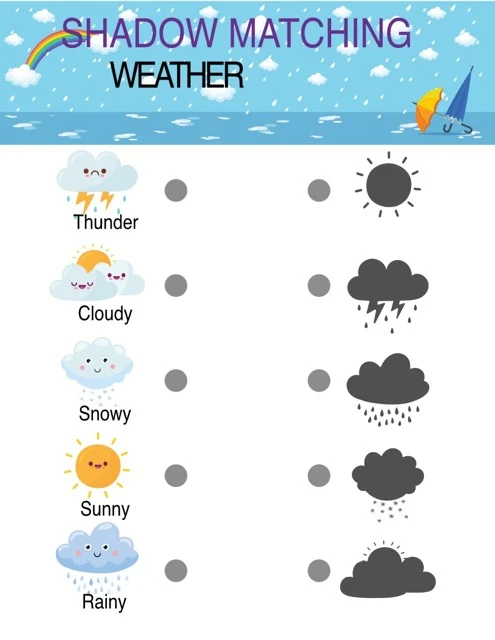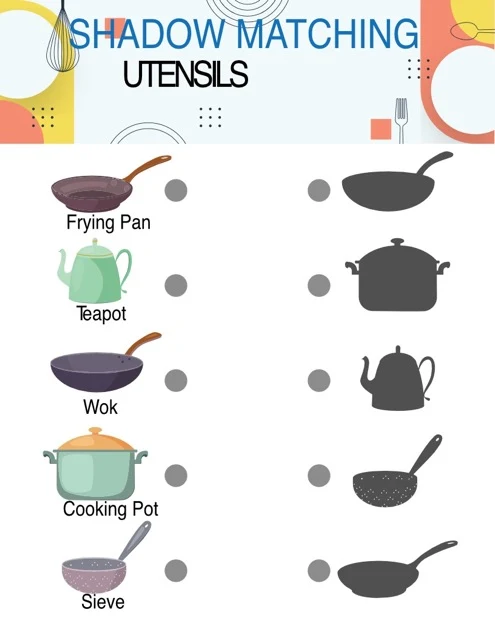Shadow Matching in Early Childhood Education
The provided text details shadow matching, an early childhood education activity where children match objects to their shadows. This activity enhances visual perception, spatial reasoning, and cognitive development, while also improving fine motor skills. The text offers adaptable methods for various age groups and suggests using diverse themes like animals, transportation, and everyday objects. Materials can range from printable worksheets to real objects, and the activity can be integrated into group settings and other subjects like art and science. Examples from sample worksheets illustrate the practical application of shadow matching in educational settings.
Shadow Matching in Early Childhood Education
Shadow Matching in Early Childhood Education: A Briefing
This document reviews the key themes and ideas related to shadow matching as an educational activity for young children, drawing from three sources: a comprehensive guide, a FAQ document, and sample shadow matching worksheets.
What is Shadow Matching?
Shadow matching is a simple activity where children match objects or images to their corresponding shadows. This seemingly basic exercise plays a significant role in developing essential skills such as:
●
Visual Perception: Recognizing shapes, forms, and subtle differences.
●
Spatial Reasoning: Understanding object position, orientation, and relationships.
●
Cognitive Development: Encouraging problem-solving, critical thinking, and observation.
●
Fine Motor Skills: Improving hand-eye coordination and precision through drawing or connecting activities.
Adaptability and Themes
One of the strengths of shadow matching is its adaptability for various age groups.
●
For toddlers and preschoolers: Simple shapes and familiar objects like circles, squares, or animals.
●
For older children: More complex images, themes, and activities incorporating rotation, distractions, or time limits.
The "Comprehensive Guide" suggests engaging themes like:
●
Animals: Matching dogs, cats, elephants, etc. to their shadows.
●
Transportation: Matching cars, trains, airplanes, etc.
●
Everyday Objects: Matching spoons, cups, chairs, etc.
●
Nature: Trees, flowers, the sun, etc.
●
Alphabet & Numbers: For early literacy and numeracy practice.
Materials and Resources
Shadow matching requires minimal materials, many of which are readily available:
●
Printable Worksheets: Abundant online resources offer free printable worksheets with varied themes.
●
Cut-outs: Paper or card stock can be used to create DIY cut-outs of objects and their shadows.
●
Real Objects: Everyday items and a flashlight can create a more interactive experience.
Group Activities and Interdisciplinary Potential
Shadow matching can be easily adapted for group activities, fostering collaboration and engagement:
●
Team challenges, interactive projections, and even "shadow charades" are suggested.
Furthermore, the guide highlights the potential for integrating shadow matching with other subject areas:
●
Art: Combining shadow tracing with creative drawing.
●
Science: Exploring light and shadow concepts.
●
Language Arts: Incorporating storytelling or descriptive language activities.
Examples from "Testing Theme: Shadow Matching.pdf"
The sample worksheets demonstrate the practicality of these concepts:
●
The themes used include hats, weather, space, and utensils.
●
A dotted line visually connects each object to its matching shadow, providing a clear and intuitive guide for young learners.
Conclusion
Shadow matching is a versatile and valuable tool for early childhood education. Its simplicity, adaptability, and engagement potential make it ideal for supporting the development of crucial cognitive, visual, and motor skills.
Shadow Matching: A Comprehensive Guide
Shadow Matching FAQ
1. What is shadow matching?
Shadow matching is a simple yet effective educational activity where children are asked to match objects or images to their corresponding shadows. This activity helps develop several crucial skills including visual perception, problem-solving, and fine motor skills.
2. What age group is shadow matching best suited for?
Shadow matching can be adapted for various age groups. Simpler shadow matching activities, featuring basic shapes and easily recognizable objects, are suitable for toddlers and preschoolers. As children grow, the complexity of the images and themes can be increased to challenge older children.
3. What are the benefits of shadow matching for children's development?
Shadow matching activities offer several developmental benefits:
●
Visual Discrimination: Children learn to differentiate between subtle differences in shapes and forms.
●
Spatial Reasoning: Matching objects to their shadows requires understanding spatial relationships and orientations.
●
Cognitive Development: Shadow matching encourages problem-solving, critical thinking, and observation skills.
●
Fine Motor Skills: The act of drawing lines or connecting objects to shadows enhances fine motor control and hand-eye coordination.
4. What themes can be used for shadow matching activities?
Shadow matching activities can be themed around various subjects, making them more engaging and educational. Some popular themes include:
●
Animals: Match animals to their shadows (e.g., dog, cat, elephant).
●
Transportation: Match vehicles to their shadows (e.g., car, train, airplane).
●
Everyday Objects: Match common household items to their shadows (e.g., spoon, cup, chair).
●
Nature: Match natural elements to their shadows (e.g., tree, flower, sun).
●
Alphabet & Numbers: Match letters and numbers to their shadows for early literacy and numeracy practice.
5. How can I make shadow matching activities more challenging?
As children become proficient with simple shadow matching, you can increase the difficulty by:
●
Using more complex shapes and images.
●
Rotating the shadows to different angles.
●
Adding distractions or similar-looking shadows.
●
Introducing a time limit.
●
Creating shadow puzzles where the child has to assemble the shadow from separate pieces.
6. What materials are needed for shadow matching activities?
You can create shadow matching activities using simple materials found at home or in the classroom:
●
Printable Worksheets: Search online for free printable shadow matching worksheets for various themes.
●
Cut-outs: Create your own cut-outs of objects and their shadows using paper or card stock.
●
Real Objects: Use everyday objects and a flashlight to create shadows for children to match.
7. How can shadow matching be adapted for group activities?
Shadow matching can be fun and interactive in a group setting. Here are some ideas:
●
Team Challenge: Divide children into teams and see which team can correctly match the most shadows.
●
Interactive Game: Project shadows on a wall and have children take turns identifying the object that casts the shadow.
●
Shadow Charades: One child acts out an object behind a sheet, while the others guess the object based on its shadow.
8. Are there any online resources for shadow matching activities?
Yes, numerous websites and apps offer interactive shadow matching games and printable worksheets. Search online using keywords like "shadow matching games," "shadow matching worksheets," or "shadow matching activities" for a variety of options suitable for different age groups and themes.
Shadow Matching: A Comprehensive Guide
Shadow Matching Study Guide
Quiz
Instructions: Answer the following questions in 2-3 sentences each.
1.
What is shadow matching, and what is its primary purpose in early childhood education?
2.
Identify three developmental benefits of shadow matching activities.
3.
How can shadow matching activities be adapted for different age groups? Provide an example.
4.
List three themes that can be used for creating engaging shadow matching activities.
5.
Describe two methods for making shadow matching activities more challenging for advanced learners.
6.
What are three common materials used for creating shadow matching activities at home or in the classroom?
7.
Suggest one way to adapt shadow matching into a fun group activity for children.
8.
Where can educators find online resources like printable worksheets and interactive games for shadow matching?
9.
Using the "Testing Theme: Shadow Matching.pdf" source, name three themes depicted in the provided shadow matching exercises.
10.
Based on the examples provided in "Testing Theme: Shadow Matching.pdf," what strategy is commonly used to visually connect a matching pair?
Quiz Answer Key
1.
Shadow matching is an educational activity where children match objects or images to their corresponding shadows. Its primary purpose is to develop visual perception, problem-solving skills, and fine motor skills in young learners.
2.
Three developmental benefits of shadow matching include improving visual discrimination (differentiating shapes and forms), enhancing spatial reasoning (understanding object positions), and fostering cognitive development through problem-solving and critical thinking.
3.
Shadow matching can be adapted by adjusting the complexity of shapes and themes. For toddlers, simple shapes like circles and squares are appropriate, while older children can match intricate images of animals or everyday objects.
4.
Engaging themes for shadow matching include animals, transportation, everyday objects, nature, and alphabet/number recognition.
5.
Shadow matching can be made more challenging by rotating shadows, introducing similar-looking distractions, adding a time limit, or using more complex shapes and images.
6.
Common materials for shadow matching include printable worksheets, cut-outs of objects and their shadows, and real objects paired with a flashlight to create shadows.
7.
One way to adapt shadow matching for a group activity is to have a "shadow charades" game. A child acts out an object behind a sheet, and the other children guess the object based on its shadow.
8.
Educators can find online resources by searching keywords like "shadow matching games," "shadow matching worksheets," or "shadow matching activities." Websites and apps offer various options for different age groups and themes.
9.
Three themes depicted in "Testing Theme: Shadow Matching.pdf" are hats, weather, and utensils.
10.
In the examples, a dotted line is used to visually connect each object to its matching shadow.
Essay Questions
1.
Discuss the role of shadow matching in developing early literacy and numeracy skills in preschool children.
2.
Analyze how shadow matching activities contribute to the development of a child's spatial reasoning and problem-solving abilities. Provide specific examples.
3.
Compare and contrast the benefits of using printable worksheets versus real objects and a flashlight for shadow matching activities. Consider different age groups and learning styles.
4.
Design a comprehensive lesson plan for a shadow matching activity aimed at a specific age group (e.g., kindergarteners). Include learning objectives, materials, procedure, differentiation strategies, and assessment methods.
5.
Explore the potential of integrating shadow matching activities with other subject areas, such as art, science, or language arts. Provide concrete examples of interdisciplinary connections.
Glossary of Key Terms
●
Visual Perception: The ability to interpret and understand visual information from the environment.
●
Problem-Solving: The process of finding solutions to challenging or complex issues.
●
Fine Motor Skills: The ability to make precise movements using the small muscles in the hands and fingers.
●
Spatial Reasoning: The ability to understand and think about objects in three dimensions and their relationships to each other.
●
Cognitive Development: The development of mental processes such as thinking, learning, and problem-solving.
●
Hand-Eye Coordination: The ability to coordinate hand movements with visual input.
●
Printable Worksheets: Educational materials that can be printed from a computer, typically used for practice or assessment.
●
Cut-Outs: Shapes or figures cut from paper or other materials.
●
Interactive Games: Games that involve active participation and engagement from the player.
●
Themes: Topics or subjects that provide a framework for educational activities.
●
Differentiation Strategies: Teaching methods that cater to the diverse learning needs of students.























